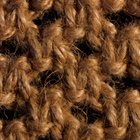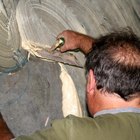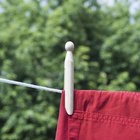
JGI/Blend Images/Getty Images
It is a form of deterioration, but dry rot actually has little to do with rotting and everything to do with mold damage. Dry rot occurs when a fabric is exposed to moisture and doesn't dry completely, or when it has been stored in a humid environment. Microscopic mold and mildew spores drift in the air, and when moisture conditions are right, they settle into the fabric and grow. The spores break down cellulose fibers such as cotton, linen, bamboo, hemp, rayon and ramie. The fabric weakening, or dry rot, happens over a period of time and may not be noticeable until the deterioration is extreme.
Keep It Clean and Dry
Before storing clothes, scrub closets and other storage areas with household cleaner to remove traces of existing mold and mildew along with substances, as they feed on such as greasy film or body oils. Use a mildew remover product for areas that previously harbored molds. Launder clothing before storing it, and make sure it's thoroughly dry. Heat from a dryer helps kill spores, as does sunlight.
Use Storage Aids and Avoid Plastic
Desiccants, such as silica gels sold in tubs or packets, absorb moisture from the air. Place desiccants in the closet as directed by the manufacturer. In damp weather, or anytime you notice a musty odor, provide air circulation by opening the closet door -- use a small fan to help move the air. Do not store clothes in plastic bags or plastic storage containers. Plastic can seal in humidity and obstruct ventilation, creating the perfect environment for mold and mildew to thrive.
Related Articles

How Do You Remove Mold Stains & Smell ...

How to Get Rid of Mold in a Gym Bag

Care of Mohair Fabric

How to Kill Moths in Wool

How to Get Rid of the Odd Smell in a ...

The Effects of Inhaling Air Dusters

How to Remove Cigarette Smoke Stains

How to Remove Loctite From Clothes

Removing White Fuzzy Mold From Dark ...

Why Do White Clothes Turn Yellow in ...

How to Clean Mold Off Leather Shoes

How to Get Rid of Bugs That Eat Holes ...

How to Prevent the Discoloration of ...

How to Make Homemade Silver Jewelry ...

How to Remove Lye Stains

How to Clean an Oilcloth Coat

Does Canned Soup Go Bad?

How to Whiten Jeans

How Long After a Sell-By Date Can You ...

How to Remove Crayola Paint From ...
References
Writer Bio
Fern Fischer's print and online work has appeared in publications such as Midwest Gardening, Dolls, Workbasket, Quilts for Today and Cooking Fresh. With a broader focus on organic gardening, health, rural lifestyle, home and family articles, she specializes in topics involving antique and modern quilting, sewing and needlework techniques.
Photo Credits
JGI/Blend Images/Getty Images